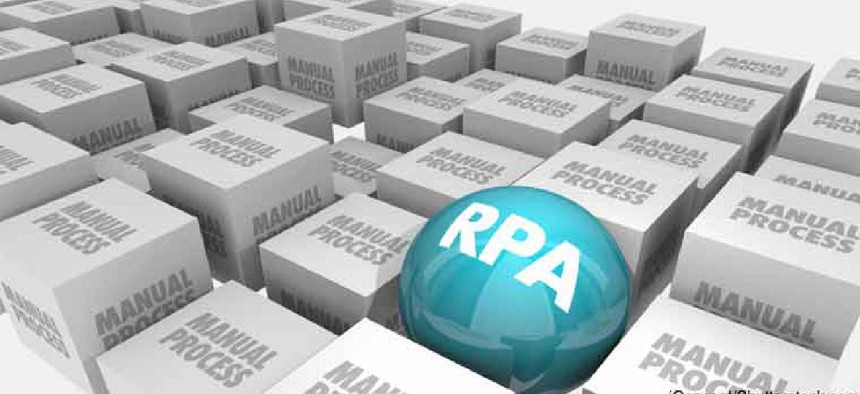RPA takes on more services delivery


Connecting state and local government leaders
One positive outcome of the coronavirus pandemic has been agencies’ increased ability to quickly adapt to new circumstances, thanks, in many cases, to their use of robotic process automation and chatbots to deliver internal and external services.
One positive outcome of the coronavirus pandemic has been agencies’ increased ability to quickly adapt to new circumstances, thanks, in many cases, to their use of robotic process automation (RPA) and chatbots to deliver internal and external services.
In Missouri, the Office of Administration’s IT Services Division, the state’s consolidated IT organization, launched a chatbot to help handle vastly more inquiries about unemployment insurance.
“Like most everybody, our unemployment insurance exploded, and in order to help relieve calls from the call center, we implemented a chatbot,” Missouri’s CIO Jeffrey Wann said. “We did it in about a week and then [spent] about a week and a half to train it.”
“We’ve got it down now so that we can deploy a chatbot technically in about 24 hours,” he said. “We’ve set up four of them now, and other areas of government are lining up. They want to do the same thing.”
At the federal level, the Centers for Medicare and Medicaid Services launched the CMS Employee Roll Call Bot that can flag when employees aren’t logging in or are having trouble accessing agency systems. It gives senior leaders a single, up-to-date visual source of information about the health of its internal IT systems, communications networks and personnel.
Other ways that RPA can help agencies during the pandemic include prioritizing help-desk response to automatically prioritize emails about suspected IT incidents related to teleworking, automating COVID-19-related cyber threat response and patching and improving telehealth scheduling to reduce virus spread.
“What we found emerge directly from this COVID crisis -- and of course the very sudden and extensive amount of teleworking that it’s created -- is that it’s shined a bright light on the need for modernization,” said Leslie Steele, CEO of IT services company InterImage. “Now, suddenly, because of this COVID crisis, it’s a much bigger conversation.”
This increased attention may be the result of the greater security risks agencies face as their attack surfaces have expanded with more remote workers who sometimes struggle to securely connect to agency networks and data and share information, she said.
Steele said the pandemic has not necessarily fast-tracked RPA projects, but it has heightened interest in the technology’s ability to solve problems quickly. That’s because bots can be created and implemented within weeks, whereas most systems take years to build, particularly when starting with a new solution.
“That is absolutely revolutionary. It doesn’t happen with any other technology,” she said.
As agencies explore RPA, they should remember that it’s easiest to apply to rules-based processes and systems that are stable and well-documented, she said. It’s harder to use with systems that change frequently because the bot has to change in response. Also, processes that require human intervention can still benefit from RPA, but they might have a lower return on investment.
Whether it’s better to buy or build a bot depends on the situation, Steele added.
“With RPA solutions, yes, they have to buy the platform that gives them the bot licenses, but the solution itself is not off the shelf,” she said. “It’s so inexpensive to develop a custom solution that it makes more sense to build than to try and buy something off the shelf that’s only going to [meet] part of their needs.”
The technology prerequisites for bots depend on the type of automation agencies need. Tended bots can run on any local machine that has Microsoft Windows 7 or higher, while unattended bots require a server and an orchestrator that fits the application they’re using.
Bots and bot components may be shared across and within agencies, typically with the help of a commercial implementation partner. The IRS, for example, is setting up an RPA library of reusable components that any developer within the agency can use, Steele said, and InterImage is helping seed that library with components for error logging or performing certain kinds of searches.
The General Services Administration has started an RPA community of practice that has 900 members across the government. Through that, there may be opportunities for sharing information and technology.
RPA has staying power, especially as workloads increase, Steele said. “Once people start working with bots,” she said, “they see that value firsthand and honestly they don’t want to go back.”




